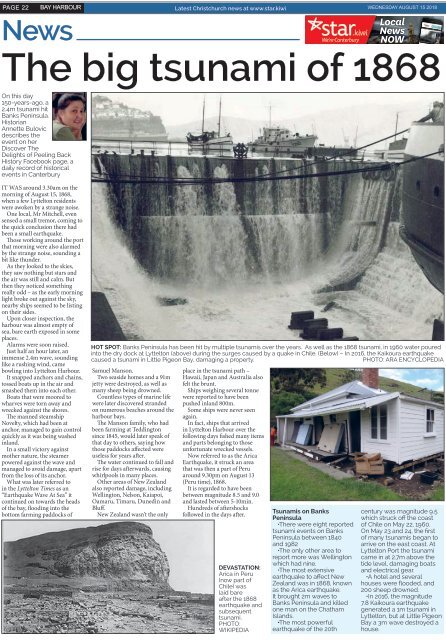Bay Harbour: August 15, 2018
You also want an ePaper? Increase the reach of your titles
YUMPU automatically turns print PDFs into web optimized ePapers that Google loves.
PAGE 22 Wednesday <strong>August</strong> <strong>15</strong> <strong>2018</strong><br />
BAY HARBOUR<br />
Latest Christchurch news at www.star.kiwi<br />
News<br />
Local<br />
News<br />
Now<br />
The big tsunami of 1868<br />
Fire rages, homes at risk<br />
On this day<br />
<strong>15</strong>0-years-ago, a<br />
2.4m tsunami hit<br />
Banks Peninsula.<br />
Historian<br />
Annette Bulovic<br />
describes the<br />
event on her<br />
Discover The<br />
Delights of Peeling Back<br />
History Facebook page, a<br />
daily record of historical<br />
events in Canterbury<br />
IT WAS around 3.30am on the<br />
morning of <strong>August</strong> <strong>15</strong>, 1868,<br />
when a few Lyttelton residents<br />
were awoken by a strange noise.<br />
One local, Mr Mitchell, even<br />
sensed a small tremor, coming to<br />
the quick conclusion there had<br />
been a small earthquake.<br />
Those working around the port<br />
that morning were also alarmed<br />
by the strange noise, sounding a<br />
bit like thunder.<br />
As they looked to the skies,<br />
they saw nothing but stars and<br />
the air was still and calm. But<br />
then they noticed something<br />
really odd – as the early morning<br />
light broke out against the sky,<br />
nearby ships seemed to be listing<br />
on their sides.<br />
Upon closer inspection, the<br />
harbour was almost empty of<br />
sea, bare earth exposed in some<br />
places.<br />
Alarms were soon raised.<br />
Just half an hour later, an<br />
immense 2.4m wave, sounding<br />
like a rushing wind, came<br />
bowling into Lyttelton <strong>Harbour</strong>.<br />
It snapped anchors and chains,<br />
tossed boats up in the air and<br />
smashed them into each other.<br />
Boats that were moored to<br />
wharves were torn away and<br />
wrecked against the shores.<br />
The manned steamship<br />
Novelty, which had been at<br />
anchor, managed to gain control<br />
quickly as it was being washed<br />
inland.<br />
In a small victory against<br />
mother nature, the steamer<br />
powered against the wave and<br />
managed to avoid damage, apart<br />
from the loss of its anchor.<br />
What was later referred to<br />
in the Lyttelton Times as an<br />
“Earthquake Wave At Sea” it<br />
continued on towards the heads<br />
of the bay, flooding into the<br />
bottom farming paddocks of<br />
HOT SPOT: Banks Peninsula has been hit by multiple tsunamis over the years. As well as the 1868 tsunami, in 1960 water poured<br />
into the dry dock at Lyttelton (above) during the surges caused by a quake in Chile. (Below) – In 2016, the Kaikoura earthquake<br />
caused a tsunami in Little Pigeon <strong>Bay</strong>, damaging a property.<br />
PHOTO: ARA ENCYCLOPEDIA<br />
Samuel Manson.<br />
Two seaside homes and a 91m<br />
jetty were destroyed, as well as<br />
many sheep being drowned.<br />
Countless types of marine life<br />
were later discovered stranded<br />
on numerous beaches around the<br />
harbour bays.<br />
The Manson family, who had<br />
been farming at Teddington<br />
since 1845, would later speak of<br />
that day to others, saying how<br />
those paddocks affected were<br />
useless for years after.<br />
The water continued to fall and<br />
rise for days afterwards, causing<br />
whirlpools in many places.<br />
Other areas of New Zealand<br />
also reported damage, including<br />
Wellington, Nelson, Kaiapoi,<br />
Oamaru, Timaru, Dunedin and<br />
Bluff.<br />
New Zealand wasn’t the only<br />
place in the tsunami path –<br />
Hawaii, Japan and Australia also<br />
felt the brunt.<br />
Ships weighing several tonne<br />
were reported to have been<br />
pushed inland 800m.<br />
Some ships were never seen<br />
again.<br />
In fact, ships that arrived<br />
in Lyttelton <strong>Harbour</strong> over the<br />
following days fished many items<br />
and parts belonging to those<br />
unfortunate wrecked vessels.<br />
Now referred to as the Arica<br />
Earthquake, it struck an area<br />
that was then a part of Peru<br />
around 9.30pm on <strong>August</strong> 13<br />
(Peru time), 1868.<br />
It is regarded to have been<br />
between magnitude 8.5 and 9.0<br />
and lasted between 5-10min.<br />
Hundreds of aftershocks<br />
followed in the days after.<br />
DEVASTATION:<br />
Arica in Peru<br />
(now part of<br />
Chile) was<br />
laid bare<br />
after the 1868<br />
earthquake and<br />
subsequent<br />
tsunami.<br />
PHOTO:<br />
WIKIPEDIA<br />
Tsunamis on Banks<br />
Peninsula<br />
•There were eight reported<br />
tsunami events on Banks<br />
Peninsula between 1840<br />
and 1982<br />
•The only other area to<br />
report more was Wellington<br />
which had nine.<br />
•The most extensive<br />
earthquake to affect New<br />
Zealand was in 1868, known<br />
as the Arica earthquake.<br />
It brought 2m waves to<br />
Banks Peninsula and killed<br />
one man on the Chatham<br />
Islands.<br />
•The most powerful<br />
earthquake of the 20th<br />
century was magnitude 9.5<br />
which struck off the coast<br />
of Chile on May 22, 1960.<br />
On May 23 and 24, the first<br />
of many tsunamis began to<br />
arrive on the east coast. At<br />
Lyttelton Port the tsunami<br />
came in at 2.7m above the<br />
tide level, damaging boats<br />
and electrical gear.<br />
•A hotel and several<br />
houses were flooded, and<br />
200 sheep drowned.<br />
•In 2016, the magnitude<br />
7.8 Kaikoura earthquake<br />
generated a 1m tsunami in<br />
Lyttelton, but at Little Pigeon<br />
<strong>Bay</strong> a 3m wave destroyed a<br />
house.


















